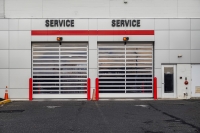HIGH SPEED OVERHEAD DOORS
By Michael Panish
Door & Door Hardware Expert Witness
Automatic Door Expert Witness
There are several manufacturers of highspeed overhead door systems in the marketplace. High speed door systems generally operate with opening speeds of between 8 to 10 feet per second. This opening speed when compared to a generic overhead door is lightning fast. Normal overhead doors can take between 15 to 45 seconds to open fully depending upon the size and composition of the door. High speed overhead doors do not descend with the same rapid opening speed, but they generally descend more rapidly than other types of overhead doors.
High speed doors are used for many purposes that usually address some type of required compartmental control. Many highspeed doors are installed where controlled temperature is needed. Others are installed for noise limiting or securing an area from unauthorized personnel. Some doors are designed and fabricated as soft curtains, others are hard rigid panels that roll into a spiral when opened, rubber doors are also commonly seen.
Common locations for soft panel curtains are loading docks, refrigerated storage areas or between fabrication and storage locations in warehouses to attempt to control dust transfer. Spiral hard panels are often used as an architectural feature in a high-tech environment. Many highspeed overhead door systems are used in automotive show rooms and between drive up service areas and the working mechanic’s bays.
All overhead doors that operate automatically require sensors to safely function. UL 325 (Underwriters Labs) has set standards for automated gates and overhead doors that specifically detail required sensor systems based upon installations. Most of the major highspeed overhead door manufacturers suggest that their door components be examined at least monthly by the owner of the door system and professionally inspected and serviced at least annually. In a high usage environment, proactive quarterly professional inspections are a good practice to ensure safety.
UL 325 requires a dedicated path of travel for pedestrians that is separate and away from the overhead door opening. Highspeed overhead doorways are not generally used for pedestrian traffic.
Fully automatic overhead door systems require multiple sensors to protect all users of these openings. In many installations there are overhead motion detecting sensors that automatically open the overhead door when a vehicle is in proximity. Manually operated installations are only opened by an attended push button. That means that a user must push an activation button to start the door ascent. A manually operated highspeed door can also be closed with the push of a button. Requirements for a manually attended button per UL 325 state that the button must be continuously held as the door descends. The operator of the push button must be within sight of the moving doorway. If the push of a button allows the door to descend without being constantly held or visually monitored and supervised, then multiple additional safety devices are required. Safety devices include, but are not limited to, a bottom edge contact sensor that reverses the door descent when no more than 10 pounds of force is encountered and/or cross threshold optical sensors that reverse the travel of the door to the fully open position when the optical beam is obstructed.
No matter how the door opens, there is usually a timer that holds the door in the open position for a preset time period unless the overhead door is fully manually operated. When an automatic door uses a hold open timer it is adjusted by the door installer and generally the hold open length of time is set by agreement with the door owner during installation or maintenance. Once the timer has counted down, the presence detecting sensors that are both factory positioned and installed and field installer positioned are polled by the motor controller board. If an all clear is determined the door will start to descend.
Some manufacturers offer a more sophisticated warning  system that provides both visual and audible warnings similar to a street cross walk and traffic control device. These warnings come in the form of changing light colors from green to yellow to red and horns or warning klaxons that preemptively alert users in the proximity of the door that the door is about to descend. It is important to have correctly positioned installed sensors to guard the openings protecting vehicular traffic and pedestrian traffic. In high noise environments such as airports or where equipment operators are wearing hearing protection due to the machines they are operating, flashing strobes or other alerting devices are often installed as a safety measure.
system that provides both visual and audible warnings similar to a street cross walk and traffic control device. These warnings come in the form of changing light colors from green to yellow to red and horns or warning klaxons that preemptively alert users in the proximity of the door that the door is about to descend. It is important to have correctly positioned installed sensors to guard the openings protecting vehicular traffic and pedestrian traffic. In high noise environments such as airports or where equipment operators are wearing hearing protection due to the machines they are operating, flashing strobes or other alerting devices are often installed as a safety measure.
Pedestrians are generally not supposed to walk through vehicular openings. However, in many automotive facilities customers and employees see an opening and follow cars or approach technicians using these doorways instead of adjacent pedestrian access doors. These unauthorized access points have often led to injury incidents with pedestrians when the highspeed door descends. In most of these automotive locations the highspeed doorway was a rigid panel installation and did not have appropriate sensor placement. Other visual warnings or signage are often missing or go unheeded.
Another common location where highspeed door injuries occur are loading docks. Highspeed overhead doors are installed where trucks deliver products and forklifts and workmen have ongoing duties. These soft curtain highspeed overhead doorways are often the location of overhead door impacts with pedestrians due to improper loading dock protocols for door operations.
In most highspeed door injury cases, there are two common types of occurrences. The first involves a pedestrian that is struck by a descending rigid frame door due to lack of appropriate sensor coverage, and the second involves a descending soft curtain bottom mast impact where there are no sensors.
Individual installations require specific installation customizations that require skilled installers that know and understand the correct methods for safeguarding all users of these doorways. Many manufacturers do not require that their products be installed by factory trained service providers. Sometimes injury claims result from improper installations made by a general contractor or door installer working on these door systems for the first time. They are not familiar with or understand why they must provide all relevant safety devices that are available from the factory. Many installers just do not know the relevant safety standards that they should be following.
All overhead door systems need to be properly installed, maintained, and serviced. Each installation is unique to that specific location. Because of the variables involved in different types of installations, injury claim investigations require a specialized knowledge and examination of every installed door system before a positive determination can be made as to the reason for the occurrence. Note that there have been many occasions when a highspeed door system was installed without any attention paid by the installer to address unique site conditions. These errors in installation have resulted in many injury claims that could have been easily avoided. Owners of these highspeed door systems generally rely upon the expertise of the contracted service provider to make appropriate installation choices on their behalf.
This article is based on general information and was not intended to be manufacturer specific.
Michael Panish is the most frequently retained expert witness in the country for both plaintiff and defense personal injury cases involving overhead doors, automatic doors, manual door systems, and gates. He has been retained on over 2500 legal cases since the year 2000. Visit Michael Panish’s website at www.constructionwitness.com for more information on his expert services and lists of other articles that he has previously written. Contact Michael Panish at (888) 902-4272 (ask for Sharon) to discuss your case. He provides unbiased and accurate assessments for all cases and will be immediately available to address your inquiries.




